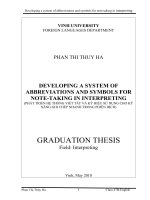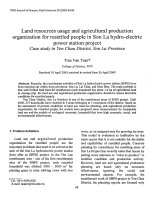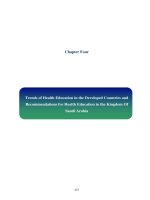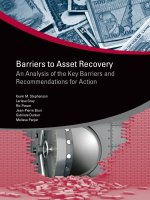ASSESSING THE AGRICULTURAL BIOMASS AND ORIENTATION FOR BIOENERGY DEVELOPMENT IN CHU SE DISTRICT, GIA LAI PROVINCE
Bạn đang xem bản rút gọn của tài liệu. Xem và tải ngay bản đầy đủ của tài liệu tại đây (263.71 KB, 6 trang )
<span class='text_page_counter'>(1)</span><div class='page_container' data-page=1>
Vietnam is a privileged country with
vast renewable energy resources, especially
biomass. However, the use of biomass for
energy applications can lead to competition
for land use, environmental degradation and
putting food security at risk. Methods of using
bio-waste and agricultural residues cause less
risk (Pham Van Lang, 2006). But up to now, the
potential residue has not been widely exploited
worldwide (UNEP, 2009). In order to have a
sustainable social and economic development
plan, a comprehensive understanding of
bio-energy potential of the region is very necessary.
In fact, information on the socio-economic
aspects of bioenergy is limited.
<b>INTRODUCTION</b>
Fossil fuels have become the main source of
global energy since the beginning of the 21st
century. During this time, a great deal of oil, gas
and coal were mined (Abdullahi, et al., 2011).
Although fossil fuels play an important role in
global economic and political development,
many environmental and ecological challenges
have led to the problem (Ramachandra et
al., 2004). Therefore, the change in using a
sustainable source of energy has been neccesary
and it is becoming more urgent (Shinnawi
et al., 1989; Fabian, 2003). Biomass energy
technology is an optimal option, not only
replacing fossil fuels but also contributing to
waste disposal.
<b>ASSESSING THE AGRICULTURAL BIOMASS </b>
<b>AND ORIENTATION FOR BIOENERGY DEVELOPMENT </b>
<b>IN CHU SE DISTRICT, GIA LAI PROVINCE</b>
<i>Le Quoc Tuan, Tran Nguyen Lam Khuong</i>
<i>Nong Lam University, Ho Chi Minh City</i>
<i>Email: </i>
<b>ABSTRACT</b>
<i>The study evaluates the amount of crop residues and their ability to turn into energy, suggesting </i>
<i>the use of agricultural waste in Chu Se district for the cogeneration process. The rate of using </i>
<i>waste burning in the field accounts for the highest rate of 52.93% followed by the use of waste to </i>
<i>make fertilizer accounted for 39.80%. By using the method of estimating residue-to-product-ratios </i>
<i>and calorific value of Thailand crop residues and using a 0.536 efficiency furnace; the results </i>
<i>show that if the total amount of waste from rice, maize, peanut and coffee is collected and used for </i>
<i>electricity generation, the total electricity generated from waste products in the whole district of </i>
<i>Chu Se is about 580097 GJ/year equivalent to 161137.978 MWh/year. This is a very useful result </i>
<i>for policy makers and managers in general and the environment in particular.</i>
<i><b>Keywords: Crop residues, Biomass, Residue-to-product ratio, Agriculture.</b></i>
<b>TÓM TẮT</b>
<i>Nghiên cứu đánh giá lượng phế phẩm cây trồng sau khi thu hoạch và khả năng chuyển đổi của </i>
<i>chúng thành năng lượng từ đó đề xuất sử dụng phế phẩm nông nghiệp huyện Chư Sê cho quy trình </i>
<i>đồng phát nhiệt điện. Tỷ lệ sử dụng phế thải đốt ngay tại ruộng chiếm tỷ lệ cao nhất 52,93% tiếp </i>
<i>theo là sử dụng phế thải để làm phân bón chiếm 39,80%. Bằng việc sử dụng phương pháp ước tính </i>
<i>lượng phế phẩm cây trồng dựa vào tỷ lệ phế phẩm theo sản lượng và giá trị nhiệt lượng phế phẩm </i>
<i>cây trồng của Thái Lan và sử dụng lò đốt với hiệu suất 0,536; kết quả cho thấy nếu toàn bộ lượng </i>
<i>phế phẩm lúa, ngô, đậu phộng, cà phê được thu gom và sử dụng để phát điện thì tổng năng lượng </i>
<i>điện từ phế phẩm có trên địa bàn tồn huyện Chư Sê trung bình khoảng 580097 GJ/năm tương </i>
<i>đương 161137,978 MWh/năm. Đây là kết quả rất hữu ích cho các nhà hoạch định chính sách và </i>
<i>quản lý nhà nước nói chung và lĩnh vực mơi trường nói riêng.</i>
</div>
<span class='text_page_counter'>(2)</span><div class='page_container' data-page=2>
The formula for assessing the status of crop
residue emissions and the ability to convert
agricultural by-products into energy.
The formula for calculating plant residue j
(Pj) is based on formula (1) as follows:
Pj = Aj Nj Rj (1)
<i>Where:</i>
Pj: Total mass of residue j (ton);
Aj: Crop area (ha);
Nj: Productivity of crops (tons/ha);
Rj: Ratio residue to quantity.
The efficiency of the rice husk and rice husk
burning equipment with reference data from the
An Khe Biomass Thermal Power Plant is 0.536.
The formula for calculating the biomass
energy that is burned from the
co-incineration-electrical plant j (Mj) calculated by formula (2)
with the moisture content and heat value of the
reference waste (Bhattacharya et al., 1993)
Mj = Pj Bj n (1 – Wj) (2)
<i>Where:</i>
Pj: Mass of crop residues (tons/year);
Ex: Moisture content of waste products (%);
Bj: Waste heat (GJ/ton);
n = Efficiency of burning (= 0.536).
The above value is used as the greenhouse
gas (ESF) savings factor to calculate the
potential for greenhouse gas emissions from the
total electricity generated from straw and husk
(EP). Total greenhouse gas emission reductions
are determined by the equation:
GHGsv = Mt ESF (3)
<i>Where:</i>
GHGsv = Greenhouse gas emissions are
reduced when straw and rice husk are converted
into energy (ton CO<sub>2</sub>-eq/year);
Mt = Total electric power of straw (MWh/
year);
ESF = GHG savings per MWh (ton CO<sub>2</sub>
-eq/MWh) is 1.252 (Suramaythangkoor and
Gheewala, 2008).
Chu Se district of Gia Lai province has
huge agricultural biomass which releases into
the environment after crop. From the idea
to convert agricultural residues to energy,
this research was conducted with the aim of
evaluating the biomass energy potential of
post-harvest crop residues from coffee, pepper, rice,
maize, cassava and peanut in Chu Se district
and proposed orientations for development of
biomass energy sources.
<b>METHODS</b>
<b>Data collecting methods </b>
The data were collected by surveying
and interviewing farmers in Chu Se district.
The questionnaire included: basic household
information; area of cultivated land, type of
crop, crop yield, seasonality of crop year,
form of crop residue use, price of defective
product and sale of crop residue. The surveyed
group of 123 farmers planted 6 main crops,
including coffee, pepper, rice, maize, cassava
and peanut. Collecting opinions on the situation
of agricultural production, using agricultural
waste in the district was also conducted as the
supporting data.
</div>
<span class='text_page_counter'>(3)</span><div class='page_container' data-page=3>
becoming popular. And with traditional
farming traditions have long taken advantage
of nature to improve. Naturally, in the face of
growing population pressures, while the area of
land for agricultural production is limited and
there is a growing risk of severe degradation,
intensification to increase resulting in crop
productivity growing. That is aconcerned
problem getting farmers’ attention. Using
agricultural waste to re-use land and improving
land is one of the usual habits because of easy
manipulation.
<b>Situation of collection and use of </b>
<b>post-har-vest waste from cultivation in Chu Se district</b>
Based on the survey results of 123 households
in Chu Se district, the percentage of waste used
in each crop is determined as (Figure 2). Crop
residue is burned in the field after each harvest
with the highest proportion because of the
farmers’ economic standard. Therefore, waste
used for cooking is less used. Particularly for
the area as the town, people’s living standards
are higher, the use of coal, gas is gradually
With the strength of land resources, Chu Se
is a land suitable for many crops and for high
productivity. Major crops produced in the
region are coffee, pepper, rice, maize, cassava
and peanuts. In 2010 - 2011, the total production
of Chu Se crops will be 17822 tons, increasing
to 20170 tons in the period of 2014 - 2015 as
shown in Table 1.
<b>RESULTS AND DISCUSSION</b>
<b>Cultivation occurrence of some crops in Chu </b>
<b>Se district</b>
Chu Se district has a total natural area of
64140 ha, of which 45631.70 ha is agricultural
land, accounting for 71.14% of total natural
area, of which 45000 ha is agricultural land.
<b>Table 1. Crop productivity in years </b>
<i>Unit: ton</i>
Crops Season
2010 – 2011 2011– 2012 2012– 2013 2013– 2014 2014– 2015
Coffee 9036 9129 9339 9412 8941
Pepper 2121 2131 2483 3487 3750
Cassava 950 800 931 929 980
Rice 3600 4182 4330 3992 4169
Maize 1977 2139 1765 2150 2150
Peanut 138 160 132 284 180
Total 17822 18541 18980 20254 20170
<i>Source: Statistical yearbook, 2015</i>
0,0
0,0
0,9
3,4
39,8
52,9
3,0
0,0 10,0 20,0 30,0 40,0 50,0 60,0
Sell to factories
Sell to dealers
Burning at home
Feed for cattles
Fertilizer
Burning at field
Other
<b>Percentage (%)</b>
</div>
<span class='text_page_counter'>(4)</span><div class='page_container' data-page=4>
<b>Electricity consume of Chu Se district</b>
Over the five years from 2010 to 2015,
although the electricity price increases
continuously and reached the highest in 2015
as 1653 VND/kWh, the demand for electricity
used by households in Chu Se district has
<b>Mass of agricultural residues in Chu Se district</b>
Based on data on major crop yields from 2011
to 2015, calculation of residues was examined
from the average crop for years through the
percentage of defective products collected.
Data collected from the interviews of farmers
in Chu Se district are not much different from
those in FAO (1982) as shown in Table 2.
However, the use of agricultural waste
burned directly in the field to obtain ash directly
applying for the soil as fertilizer induces wasting
the source of agricultural residues after harvest.
On the other hand, residue burning causes
environmental pollution that affects human
health; it badly affects the lives and activities of
people in the research area.
<b>Table 2. Mass of residues from cultivation activities in Chu Se district </b>
No. Crops <sub>(Ton/yr)</sub>Prod. From production Residues Residue ratio Residue mass<sub>(ton/yr)</sub>
processes On field
1 Coffee 21560 Branch and leave 2.1 45276
Husk 1.4 30184
2 Pepper 10312 Branch and leave -
-3 Cassava 14810 Stem 0.062 918.2
4 Maize
10438 Cop <sub>Stem</sub> 0.273<sub>2.0</sub> <sub>20877.6</sub>2849.8
Husk 0.2 2087.76
5 Rice 15812 Husk 0.267 4220.8
Straw 1.757 27782
6 Peanut 1700.6 Husk 3.5 5952
not decreased. The corresponding increase
in demand for electricity is relatively high.
Transforming biomass from agricultural
by-products to energy will create a new form of
energy in rural areas that is complementary to
traditional energy.
<b>Table 3. Electricity production and trading data of electricity from 2010 to 2015 in Chu Se</b>
Year Electricity output
(kWh) (VND)Price Customer Customer 3P Customer 1P Electricity output(kWh/household)
2010 67798870 997 34949 1000 33949 1940
2011 56504949 1233 36135 1236 34899 1564
2012 67338270 1388 38105 1374 36731 1767
2013 63979791 1524 26122 872 25250 2449
2014 51658741 1581 27962 983 26979 1848
2015 58595023 1653 29395 1115 28280 1993
<i>(Source: Statistical yearbook, 2015)</i>
<b> Estimation of power supply capacity from </b>
<b>biomass of crop residues in Chu Se district</b>
The energy potential of crop residues is
calculated according to the research method
</div>
<span class='text_page_counter'>(5)</span><div class='page_container' data-page=5>
<b>Suggested model for biomass energy use</b>
Rice husk and rice husk residues can be used
as co-incineration fuel, including the following
main components: combustion chamber, boiler,
turbine, generator, heat exchanger, dryer and
other auxiliary parts.
Principle of working: The pump system
will supply water to the boiler; fuel (rice husk,
rice straw) will supply to the burner. The
heat generated from the combustion process
is provided to the boiler. The amount of heat
generated by the combustion at the furnace is
provided to the boiler to evaporate the steam.
The superheated steam creates a spinning
turbine that rotates the generator, releasing
electricity. Pressure for the turbine is about
9.81 Mpa. This power supply can be supplied
in-house for the dryer or in the milling system.
The combustion of some high-moisture
fuels releases water in the combustion chamber.
As a result, the formation and evaporation of
purposes, would generate 208236 GJ/year, or
57843.33 MWh/year, accounting for 35.90% of
total energy potential. The remaining 20.89%
are the crop residues such as maize stem, maize
cobs, rice husks, peanut stem.
Thus, if the total amount of rice, maize,
peanut and coffee waste is collected and used
for electricity generation, the total electricity
from waste in the whole district of Chu Se is
about 580097 GJ/year equivalent to 161137.978
MWh/year.
16.02; Peanut stem: 12,38. Thailand’s defected
moisture content in units (%): coffee husk: 15;
maize stem: 22; maize cob: 7.53; rice husk:
12.37; rice straw: 12,71; Peanut stem: 15. These
are the best values to use in calculating the energy
potential of crop residues (Suramaythangkoor
T. and Gheewala S.H., 2008).
According to the calculation results of Chu
Se district, the potential energy of coffee husk is
255372 GJ/year, equivalent to 70936.62 MWh/
year, accounting for 44.02% of total energy
potential of waste, followed by straw for energy
<b>Table 4. Annually average energy potential from residues in Chu Se district</b>
Crops Residue kinds Wet mass <sub>(ton)</sub> Humidity<sub>(%)</sub> Dried mass <sub>(ton)</sub> <sub>(GJ/ton)</sub>Heat Energy<sub>(GJ/yr)</sub>*
Coffee <sub>Husk</sub> <sub>45276</sub> <sub>15</sub> <sub>38484.60</sub> <sub>12.38</sub> <sub>255372</sub>
Maize Stem 20877.6 22 16284.53 5.25 45823
Cop 2849.79 7.53 2635.20 16.28 22994
Rice Husk 4221.86 12.37 3699.61 19.33 38329
Straw 27782.04 12.71 24250.94 16.02 208236
Peanut Stem 1656.55 15 1408.07 12.38 9342
Total 103582.06 87543.44 580096
<i>Remarked: * The energy potential of residues with process efficiency is 0.536</i>
water in the combustion chamber reduces
the amount of thermal energy available to
work. However, this system has a secondary
condensation process, below the combustion
step, which condenses the water vapor in the
exhaust stream and recovers most of the latent
heat that is carried. Recovered heat can be used
more efficiently and maximize the amount of
heat generated from crop residues. Heat from
the steam from the turbine (steam) is used to
dry agricultural products.
<b>CONCLUSION</b>
</div>
<span class='text_page_counter'>(6)</span><div class='page_container' data-page=6>
<i>Pham Van Lang, 2006. Sử dụng chất thải sinh </i>
<i>khối trong sản xuất nông – lâm nghiệp bằng </i>
<i>công nghệ đốt tầng sôi để phát nhiệt - điện, </i>
Hội nghị Khoa học tại Hà Nội.
Ramachandra T.V., Kamakshi G. and Shruthi
B.V., 2004. Bioresource status in Karnataka.
<i>Renewable and Sustainable Energy Reviews </i>
8 (4): 1–47.
Shinnawi E. M. M., Tahawi E. B. S., Houseini
E. M., Fahmy S. S., 1989. Applied
<i>Microbiology. Biotechnology (5): 475-486.</i>
Suramaythangkoor T. and Gheewala S.H., 2008.
Potential of practical implementation of rice
straw-based power generation in Thailand.
<i>Energy policy 36: 3193-3197.</i>
<i>UNEP, 2009. Towards sustainable production </i>
<i>and use of resources – Assessing Biofuels. </i>
Nairobi: United Nations Environment
Programme.
<i>General Department of Statistics, 2015. Vietnam </i>
<i>Statistical Yearbook 2015.</i>
Therefore, it is necessary to study the
planning, collection and transportation of
rice by-products as well as other agricultural
by-products to determine the efficiency of
investment in processing plants and the efficient
use of crop residues with both economic and
environmental concerns.
<b>REFFERENCE</b>
Abdullahi I. I., A., Musa A. O. and Galadima
<i>A. ,2011. European Journal of Scientific </i>
<i>Research 57 (4): 626-634.</i>
Bhattacharya S.C., Pham H.L., Shrestha R.M.
<i>and Vu Q.V., 1993. CO<sub>2</sub> emissions due to </i>
<i>fossil and traditional fuels, residues and </i>
<i>wastes in Asia, AIT Workshop on Global </i>
Warming Issues in Asia, 8-10 September
1992, AIT.
<i>Fabian M., 2003. An introduction to anaerobic </i>
<i>digestion of organic wastes. Scotland: </i>
Remade.
<i>FAO, 1982. Agricultural Residues: Bibliography </i>
</div>
<!--links-->









